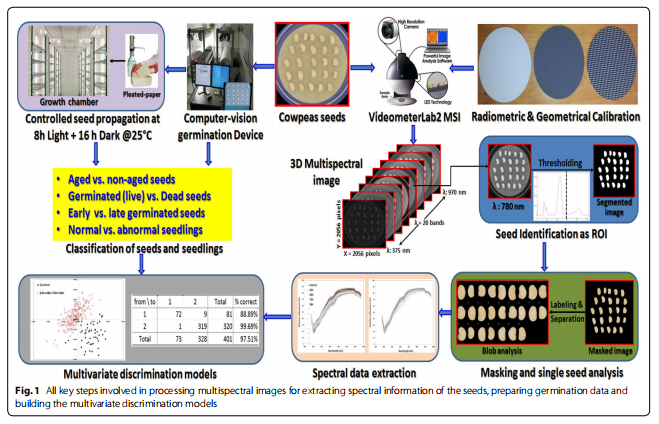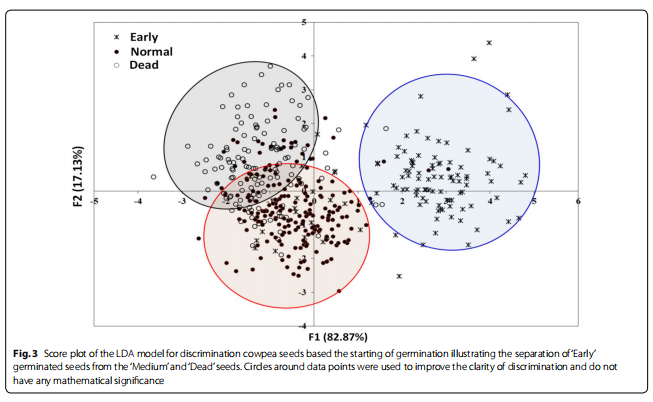品质至上,客户至上,您的满意就是我们的目标
技术文章
当前位置: 首页 > 技术文章
利用VideometerLab多光谱成像系统以及机器视觉鉴别分类豇豆种子
发表时间:2020-04-27 10:43:43点击:1141
来源:北京博普特科技有限公司
分享:
较近法国科学家利用VideometerLab 3多光谱成像系统对豇豆种子进行分类研究,Videometerlab多光谱成像系统是较较好的多光谱成像系统以及种子表型、种质资源库建设工具。
背景:传统种子评估方法通常用破坏性取样方法,之后进行机械、生理、生物化学和分子检测。尽管证实有效,此类方法广受质疑的一点是具有破坏性,耗时、耗力、需要有经验种子分析人员参与。该研究的目标是探讨计算机视觉以及多光谱成像系统结合多变量分析法在高通量鉴别豇豆种子上的应用。研究中采用了自动机器视觉生成系统(VideometerLab3),无间断监控种子(休眠和萌发阶段)来区分不同类别的单个种子。利用从多光谱图像中提取的单个豇豆种子的光谱特征,开发了基于线性判别式分析(LDA)的不同多变量分析模型,依据年龄、活力、发芽条件以及发育速度将种子进行分类。
结果: 结果显示LDA 模型在区分“老化”和“非老化”种子方面的全面正确区分率(OCC) 分别达到97.51, 96.76一级97%, ‘发芽’和‘非发芽‘种子全面正确区分率为81.80,79.05和81.0%,‘初步萌发’, ‘中度萌发’和‘死’种子的OCC分别为77.21,74.93以及68.00%。在给出“正常”以及“异常”发芽的训练集、交叉验证以及独立验证数据集的OCC值分别为68.08, 64.34以及62.00%。研究开发了图像处理流程,利用像素区分模型,探索多光谱成像系统在对不同类种子视觉区分的应用潜力。
结论: 结果显示多光谱成像系统可在紫外、可见光以及短波近红外波段提供必要的将单个豇豆种子区分到不同类别的信息。考虑到拍摄时间短以及制备样品有限等情况,该先进的多光谱成像方法以及化学计量分析法对需要在线对种子进行经济分类、实时分拣以及评级过程来说较有价值,系统不仅提供了形态学和物理学特征,还提供了检测种子的化学信息。开发执行针对种子品质检测的图像处理算法、降低成本并增加计算机硬件的使用,在种子品质自动检测领域使用计算机集成系统将对业界有巨大吸引力。
北京博普特科技有限公司是丹麦Videometer公司中国区总代理,全面负责其系列产品在中国市场的推广、销售和售后服务。


Utilization of computer vision and multispectral imaging techniques for classifcation of cowpea (Vigna unguiculata) seeds
Gamal ElMasry1,4, Nasser Mandour1, Marie‑Hélène Wagner2, Didier Demilly2, Jerome Verdier4, Etienne Belin3,4 and David Rousseau
Abstract
Background: The traditional methods for evaluating seeds are usually performed through destructive sampling followed by physical, physiological, biochemical and molecular determinations. Whilst proven to be efective, these approaches can be criticized as being destructive, time consuming, labor intensive and requiring experienced seed analysts. Thus, the objective of this study was to investigate the potential of computer vision and multispectral imaging systems supported with multivariate analysis for high-throughput classifcation of cowpea (Vigna unguiculata) seeds. An automated computer-vision germination system was utilized for uninterrupted monitoring of seeds during imbibition and germination to identify diferent categories of all individual seeds. By using spectral signatures of single cowpea seeds extracted from multispectral images, diferent multivariate analysis models based on linear discriminant analysis (LDA) were developed for classifying the seeds into diferent categories according to ageing, viability, seedling condition and speed of germination.
Results: The results revealed that the LDA models had good accuracy in distinguishing ‘Aged’ and ‘Non-aged’ seeds with an overall correct classifcation (OCC) of 97.51, 96.76 and 97%, ‘Germinated’ and ‘Non-germinated’ seeds with OCC of 81.80, 79.05 and 81.0%, ‘Early germinated’, ‘Medium germinated’ and ‘Dead’ seeds with OCC of 77.21, 74.93 and 68.00% and among seeds that give ‘Normal’ and ‘Abnormal’ seedlings with OCC of 68.08, 64.34 and 62.00% in training, cross-validation and independent validation data sets, respectively. Image processing routines were also developed to exploit the full power of the multispectral imaging system in visualizing the diference among seed categories by applying the discriminant model in a pixel-wise manner.
Conclusion: The results demonstrated the capability of the multispectral imaging system in the ultraviolet, visible and shortwave near infrared range to provide the required information necessary for the discrimination of individual cowpea seeds to diferent classes. Considering the short time of image acquisition and limited sample preparation, this stat-of-the art multispectral imaging method and chemometric analysis in classifying seeds could be a valuable tool for on-line classifcation protocols in cost-efective real-time sorting and grading processes as it provides not only morphological and physical features but also chemical information for the seeds being examined. Implementing image processing algorithms specifc for seed quality assessment along with the declining cost and increasing power of computer hardware is very efcient to make the development of such computer-integrated systems more attractive in automatic inspection of seed quality.